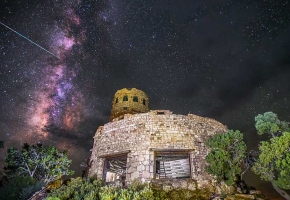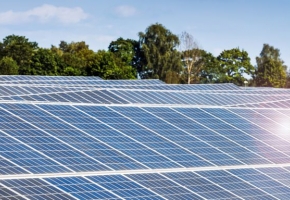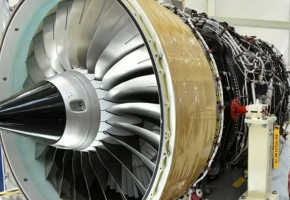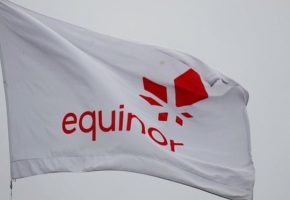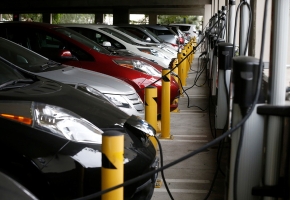California is throttling back record levels of solar—and that’s bad news for climate goals

Californians are enjoying a sunny spring, which means the state’s solar farms and rooftop panels are flooding the grid with electricity.
The problem is, they’re producing so much that plummeting prices and mandates by the state’s grid operator are forcing renewable power plants to throttle back production. In April, California solar and wind farms shut down or dialed back nearly 95,000 megawatt-hours of electricity, a new record, according to the California Independent System Operator, which manages the vast majority of the state’s electricity. That’s enough to power more than 30 million homes for an hour.
This oversupply of solar is occurring because California has added vast amounts of renewable-energy generation in recent years, mainly to meet policy mandates requiring half the state’s electricity to come from carbon-free sources by 2030 With additional generation coming online in the next few years, the state is on pace to reach that target a decade ahead of schedule.
California’s recently adopted rule requiring most new homes to include rooftop solar panels will further aggravate this issue, because it adds solar supply even as it reduces demand. (See “California’s rooftop solar rule is a pricey path to emissions reductions.”)
Isn’t more clean power a good thing?
It’s absolutely good news for climate goals and reducing carbon emissions. But that success is also creating very real challenges, placing both economic and physical strains on the power system.
These limitations could discourage additional deployment of renewable energy, undermining broader efforts to overhaul the power sector. Indeed, that’s partly why the pipeline for additional solar projects is already narrowing in California.
Many regions and nations will experience similar growing pains as they ramp up renewable generation. “This is a leading indicator of trouble for the whole country,” says James Bushnell, an energy economist at the University of California, Davis.
The basic problem is that within a given area, electricity production from every solar panel basically increases and decreases at the same times, as the sun rises and sets. On top of that, solar generation peaks in the middle of the day, when electricity demand ebbs.
As it stands, California’s system has limited ability to store that power, send it elsewhere, or balance it out with other renewable resources like wind. So the more solar California adds, the less valuable it becomes.
Wait, don’t we want clean energy to be cheap?
Up to a point, yes. But cost and price are not the same. In a normally functioning market, prices that regularly drop to zero will eat deeply into the profits of power plant operators, strongly discouraging companies from bringing more facilities online.
“This value deflation problem could halt solar’s rise down the road,” writes Varun Sivaram, a fellow at the Council on Foreign Relations, in his new book Taming the Sun.
Significantly increasing the supply of renewable sources will place growing pressure on wholesale energy prices across the board, particularly squeezing the profits of inflexible generators like solar, wind, and nuclear, according to a Lawrence Berkeley National Laboratory study released last week. If solar provides 30 percent of the grid’s demands and wind supplies 10 percent, the prices for power from those sources will fall 39 percent in the New York market in 2030, and 27 percent in California, the researchers found.
The market signal is saying we “need to slow down the build-out of those resources, or bring costs down even further to be cost-competitive,” says Andrew Mills, a research scientist at Berkeley Lab and a coauthor of the study.
The impact of these forces on the prices that consumers and businesses pay is complicated. In a perfectly competitive marketplace, dropping wholesale prices should translate to lower prices for end customers as well. But in California, where the state is also adding transmission, retiring fossil-fuel plants, and mandating the build-out of renewables, prices have remained high relative to those in other states that have seen declines, Bushnell notes.
“The retail price is paying for excess capacity that’s driving the wholesale price down,” he says.
So how can we fix this?
It’s likely to require a combination of policy, infrastructure, innovation, and a lot of investment. States like California will need far more energy storage to bank energy for times when the sun isn’t shining or the wind isn’t blowing, but current options are very expensive or geographically restricted. Regions could also build out long-range transmission lines to balance out renewable energy across larger areas, but doing that is politically fraught.
Still another possibility is shifting the timing of demand itself, by setting up programs to encourage residential or business customers to draw on electricity at different hours. That could include getting residents to charge electric vehicles in the middle of the day, instead of at night.
A study published this week in Environmental Research Letters found that it could be far cheaper for California to rely on electric vehicles to balance out renewable power instead of expanding stationary storage with, for example, banks of batteries.
But ultimately, it’s a problem that’s likely to require new, better grid-scale storage, flexible nuclear reactors, or generation that pairs with storage like concentrating solar plants (see “To make solar really work, turn up the heat”). And that won’t be cheap.
